A Critical Review of Standards to Examine the Parameters of Child-Friendly Environment (CFE) in Parks and Open Space of Planned Neighborhoods: A Case of Lucknow City, India
Abstract
1. Introduction
2. Literature Review
2.1. Parameters of Child-Friendly Environment
2.2. Open Space/Parks Standards
2.2.1. International Standards
2.2.2. International Cases
2.2.3. National Standards (India)
3. Case Study: Lucknow City
4. Materials and Methods
5. Analysis and Results
5.1. Identification of Child-Friendly Parameters
5.2. Validation of Parameters for Child-Friendly Environment by the Experts
5.3. Validation of Parameters for Child-Friendly Environment by the Children
5.4. Reviewing the Standards of Parks/Open Spaces
6. Discussion
7. Conclusions
Author Contributions
Funding
Institutional Review Board Statement
Informed Consent Statement
Data Availability Statement
Acknowledgments
Conflicts of Interest
Appendix A
| S.N. | Master Plans | Existing Scenario of Recreation/Open Space | Proposed Scenario of Recreation/Open Space | ||||||||
|---|---|---|---|---|---|---|---|---|---|---|---|
| Land Use Year | Population | Total (Ha) | Rec. Open Space | Open Space m2/capita | Prop. Land Use (Year) | Population | Total (Ha) | Rec./Open Space | Open Space m2/capita | ||
| 1 | Chennai | 2006 | 4,509,210 | 17,553 | 366 | 0.81 | 2026 | 12,582,000 | 17,617.7 | 1000.65 | 0.80 |
| 2 | Varanasi | 1999 | 1,091,918 | 14,494.4 | 2705.76 | 24.78 | 2011 | 1,201,815 | 17,927.22 | 984.47 | 8.19 |
| 3 | Jaipur | 2011 | 3,073,350 | 30,830 | 3461 | 11.26 | 2025 | 6,495,000 | 19,800 | 5745 | 8.85 |
| 4 | Ghaziabad | - | - | 8445 | 399.5 | - | 2021 | 2,300,000 | 15,554 | 2484 | 10.80 |
| 5 | Bhopal | 2005 | 1,571,182 | 17,500 | 2925 | 18.62 | 2028 | 352,000 | 15,572.12 | 646.46 | 18.37 |
| 6 | Portblair | 2001 | 99,984 | 1774 | 101.25 | 10.13 | 2021 | 4,500,000 | 41,360 | 8400 | 18.67 |
| 7 | Lucknow | 2004 | 2,358,393 | 16,270 | 2455 | 10.41 | 2021 | 1,270,000 | 21,570 | 5000 | 39.37 |
| 8 | Greater Noida | 2011 | 107,676 | 13,570 | 3000 | 278.61 | 2031 | 149,256 | 1500 | 240 | 16.08 |
| 9 | Tara Taran | 2010 | 72,337 | 569 | 63.7 | 8.81 | 2031 | 149,256 | 1500 | 240 | 16.08 |
| 10 | Srinagar | 2000 | 1,200,000 | 11,527 | 481.31 | 4.01 | 2021 | 2,350,000 | 23,853.94 | 2853.01 | 12.14 |
| 11 | Allahabad | 2001 | 1,081,622 | 21,689.13 | 2602.696 | 24.06 | 2021 | 2,043,735 | 30,917.38 | 4953.47 | 24.24 |
| 12 | Ludhiana | 2007 | 1524,081 | 127,122 | 300 | 1.97 | 2021 | 4,800,000 | 127,122 | 7416 | 15.45 |
| 13 | Batla | 2010 | 190,418 | 1474.19 | 11.9 | 0.62 | 2031 | 346,651 | 3467 | 346.7 | 10.00 |
| 14 | Noida | 2010 | 1,068,228 | 9210.74 | 1761.98 | 16.49 | 2031 | 2,500,000 | 15,279 | 2432.82 | 9.73 |
| 15 | Amritsar | 2010 | 1,976,050 | 139,419.5 | 186.8 | 0.95 | 2031 | 3,017,936 | 16,594 | 2489.1 | 8.25 |
| 16 | Banglore | 2003 | 6,501,343 | 42,141 | 1310 | 2.01 | 2011 | 8,015,000 | 56,463 | 7788 | 9.72 |
| 17 | Mysore | 2009 | 7,786,510 | 27,864.32 | 766.31 | 0.98 | 2031 | 2,100,000 | 27,863.83 | 1584.2 | 7.54 |
| 18 | Dehradun | 2004 | 753,420 | 9698.97 | 222.8 | 2.96 | 2025 | 1,530,000 | 35,867.2 | 928.17 | 6.07 |
| 19 | Kanpur | 2001 | 2,551,000 | 89,131 | 959.08 | 3.76 | 2021 | 4,000,000 | 33,703.99 | 3221 | 8.05 |
| 20 | Trivandraum | 2012 | 989,099 | 21,586 | 54 | 0.55 | 2031 | 1,032,292 | 21,586 | 101.64 | 0.98 |
| 21 | Aizwal | - | - | - | - | - | 2030 | 820,000 | 15,280 | 244 | 2.98 |
| 22 | Chandigarh | 2011 | 1,054,686 | 6648.23 | 1838.26 | 17.43 | 2031 | 1,600,000 | 11,400.00 | 3152.91 | 19.71 |
Appendix B
| Source of Variation | SS | df | MS | F | p-Value | F Crit | |
|---|---|---|---|---|---|---|---|
| Accessibility | Between Groups | 8.73573117 | 3 | 2.911910391 | 1.42582291 | 0.248336798 | 2.82162822 |
| Amenities and Facilities | Between Groups | 5.44715974 | 3 | 1.815719914 | 0.690289944 | 0.56296573 | 2.82162822 |
| Traffic | Between Groups | 7.90271530 | 3 | 2.634238433 | 0.86698691 | 0.465562674 | 2.82162822 |
| Pollution | Between Groups | 3.04432286 | 3 | 1.014774288 | 0.380852463 | 0.767283354 | 2.82162822 |
| Openness | Between Groups | 12.28914556 | 3 | 4.096381853 | 1.461544537 | 0.238379148 | 2.82162822 |
| Walkability | Between Groups | 6.43899358 | 3 | 2.146331194 | 1.00986366 | 0.397653893 | 2.82162822 |
| Location | Between Groups | 6.18357488 | 3 | 2.061191626 | 0.68949596 | 0.563556643 | 2.827048712 |
| Organization of Space | Between Groups | 2.14344478 | 3 | 0.714481594 | 0.371461649 | 0.773977175 | 2.82162822 |
| Play Variety | Between Groups | 6.74982776 | 3 | 2.249942587 | 1.109393105 | 0.355747544 | 2.82162822 |
| Adventure | Between Groups | 15.94675447 | 3 | 5.315584825 | 2.348407688 | 0.0858602 | 2.82162822 |
| Safety | Between Groups | 8.89766971 | 3 | 2.965889902 | 1.151418135 | 0.339305569 | 2.82162822 |
| Independence | Between Groups | 16.77441405 | 3 | 5.59147135 | 2.540776406 | 0.06886979 | 2.82162822 |
| Sense of Belongingness | Between Groups | 19.21652 | 3 | 6.405508 | 2.610507 | 0.056273 | 2.705838 |
| Diversity | Between Groups | 11.12324890 | 3 | 3.707749634 | 1.502516651 | 0.227435392 | 2.82162822 |
| Natural Attributes | Between Groups | 10.33290200 | 3 | 3.444300667 | 1.387288679 | 0.259875443 | 2.827048712 |
| Aesthetics | Between Groups | 22.54178994 | 3 | 7.513929979 | 2.273799643 | 0.093545815 | 2.82162822 |
| Scale of Play Equipment | Between Groups | 5.54715974 | 3 | 1.849053248 | 0.597787097 | 0.619922715 | 2.82162822 |
| Social Interactions | Between Groups | 6.43169875 | 3 | 2.143899583 | 0.834886906 | 0.482136988 | 2.82162822 |
| Visual Interactions | Between Groups | 8.29204323 | 3 | 2.76401441 | 0.85724958 | 0.470538301 | 2.82162822 |
References
- Adams, Eileen, and Sue Ingham. 1998. Changing Places: Children’s Participation in Environmental Planning. London: Children’s Society. [Google Scholar]
- Adams, Sabirah, Shazly Savahl, Maria Florence, and Kyle Jackson. 2018. Considering the Natural Environment in the Creation of Child-Friendly Cities: Implications for Children Subjective Well-Being. Child Indicators Research 12: 545–67. [Google Scholar] [CrossRef]
- Adler, Michael, and Erio Ziglio. 1996. Gazing into the Oracle: The Delphi Method and Its Application to Social Policy and Public Health. London: Jessica Kingsley. [Google Scholar]
- Agarwal, Krati, Mohit Kumar Agarwal, and Aurobindo Ogra. 2019. Sustainable retrofitting of Urban Transitions through Socio-Technical Regimes: An Assessment of Moradabad City. Paper presented at International Conference on Sustainable Globalization (ICSG 2019), Kochi, India, January 10–12; ISBN 9789353460020. [Google Scholar]
- American Society of Landscape Architects (ASLA). 2015. The Psychology of Urban Play: The Human Dimension of the City. Chicago: Playground Professionals. [Google Scholar]
- Anbari, Maral, and Hossein Soltanzadeh. 2015. Child Oriented Architecture from the Perspective of Environmental Psychology. Natural and Social Sciences, 137–45. [Google Scholar]
- ARUP. 2017. Cities Alive: Designing for Urban Childhoods. London: ARUP. [Google Scholar]
- Atiyat, Diala. 2016. Relationship of Children Psychology and Use of Public Parks: Case Study of Baiha Amman Jordan. Journal of Architectural Engineering Technology 5: 173. [Google Scholar] [CrossRef]
- Awad, Zuhal Eltayeb. 2018. Evaluating Neighborhoods Developed Open Spaces in Khartoum-Sudan. Civil Engineering and Architecture 6: 269–82. [Google Scholar] [CrossRef]
- Ghanbari-Azarneir, Sharareh, Sara Anbari, Seyed-Bagher Hosseini, and Seyed-Abbas Yazdanfar. 2015. Identification of Child-Friendly Environments in Poor Neighborhoods. Procedia Social and Behavioral Sciences 201: 19–29. [Google Scholar] [CrossRef]
- Bell, Simon, Val Hamilton, Alicia Montarzino, Helen Rothnie, Penny Travlou, and Susana Alves. 2008. Greenspace Scotland Research Report. Stirling: Stirling University Innovation Park. [Google Scholar]
- Benjamin, Solomon. 2008. Occupancy Urbanism: Radicalizing Politics and Economy beyond Policy and Programs. International Journal of Urban and Regional Research 32: 719–29. [Google Scholar] [CrossRef]
- Bhagat, R. B. 2018. Development Impacts of Migration and Urbanisation. Economic & Political Weekly 53: 15–19. [Google Scholar]
- Birch, Jo, Curtis Penny, and Allison James. 2007. Sense and Sensibilities: In Search of the Child-Friendly Hospital. Children, Young People, and Built Environments 33: 405–16. [Google Scholar] [CrossRef]
- Botsoglou, Kafenia, and Domna-Mika Kakana. 2010. Play Value and Safety in Greek Playgrounds. Paper presented at 25th ICCP World Play Conference, New Goals for the Future Children Play, Lisbon, Portugal, June 17–19. [Google Scholar]
- Castonguay, Genevie’ve, and Sylvie Jutras. 2009. Children’s Appreciation of Outdoor Places in a Poor Neighborhood. Journal of Environmental Psychology 29: 101–9. [Google Scholar] [CrossRef]
- Census. 2011. Census of India District Census Handbook Lucknow. Uttar Pradesh: Directorate of Operations. [Google Scholar]
- Chatterjee, Sudeshna. 2006. Children’s Friendship with Place: An Exploration of Environmental. Ann Arbor: Proquest Information and Learning Company. [Google Scholar]
- Chawala, Louise. 1992. Childhood place attachments. In Place Attachment. Edited by Irwin Altman and Low Setha M. New York: Plenum Press, pp. 63–86. [Google Scholar]
- Cilliers, Elizelle Juanee, and Selna Cornelius. 2019. The Creation of Rural Child-Friendly Spaces: A Spatial Planning Perspective. Applied Research Quality Life 14: 925–39. [Google Scholar] [CrossRef]
- Crane, Stacey, and Marion E. Broom. 2017. Understanding Ethical Issues of Research Participation from the Perspective of Participating Children and Adolescents: A Systematic Review. Worldviews on Evidence-Based Nursing 14: 200–9. [Google Scholar] [CrossRef]
- Crow, Lester D., and Alice Crow. 1962. Child Psychology. New York: Barnes & Noble Books. [Google Scholar]
- Danica, Stankovic. 2008. Space in the function of Psychological Stability of a child. Facta Universitatis-Series Architecture and Civil Engineering 6: 229–33. [Google Scholar]
- Davis, Adrian, and Linda J. Jones. 1996. Children in the Urban Environment: An Issue for the New Public Health Agenda. Health & Place 2: 107–13. [Google Scholar]
- Delbecq, Andre L., Andrew H. Van de Ven, and David H. Gustafson. 1975. Group Techniques for Program Planning: A Guide to Nominal Groups and Delphi Process. Glenview: Scott Foresman Company. [Google Scholar]
- Dhar, Devashish, and Manish Thakre. 2020. No Child’s Play: The Enduring Challenge of Creating Child-Friendly Cities. ORF Issue Brief 415: 1–10. [Google Scholar]
- Driskell, David. 2001. Creating Better Cities with Children and Youth: A Manual for Participation. London: Routledge. [Google Scholar]
- Drown, Kimberly K. Cloward, and Keith M. Christensen. 2014. Dramatic Play Affordances of Natural and Manufactured Outdoor Settings for Preschool-Aged Children. Children Youth and Environments 24: 53–57. [Google Scholar] [CrossRef]
- Erikson, Erik H. 1995. Childhood and Society. New York: Vintage. [Google Scholar]
- Frumkin, Howard, Lawrence D. Frank, and Richard Jackson. 2004. Urban Sprawl and Public Health. Washington, DC: Island Press. [Google Scholar]
- Garg, Abhinav. 2011. Don’t be ‘Selfish Giant’, Let Kids Play in the Park: HC to RWA. Available online: https://timesofindia.indiatimes.com/city/delhi/dont-be-selfish-giant-let-kids-play-in-park-hc-to-rwa/articleshow/8104149.cms#:~:text=NEW%20DELHI%3A%20In%20a%20significant,a%20park%20as%20a%20playground (accessed on 14 October 2020).
- Gibson, James J. 1979. The Ecological Approach to Visual Perception. Boston: Houghton Mifflin. [Google Scholar]
- Gleeson, Brendan, Neil Sipe, and Rolley Kylie. 2006. Pathways to the Child-Friendly Cities. In Creating Child-Friendly Cities: Reinstating Kids in the City. London: Routledge. [Google Scholar]
- Hart, Roger. 2002. Containing Children: Some lessons on planning for play from New York City. Environment and Urbanization 14: 135–48. [Google Scholar] [CrossRef]
- Hart, Roger A. 1997. Children’s Participation: The Theory and Practice of Involving Young Citizens in Community Development and Environmental Care. New York: Earthscan/UNICEF. [Google Scholar]
- Horelli, Liisa. 1998. Creating Child-Friendly Environment. Childhood 5: 225–39. [Google Scholar] [CrossRef]
- Horelli, Liisa. 2007. Constructing a Theoretical Framework for Environmental Child-Friendliness. Children, Youth, and Environments 17: 268–98. [Google Scholar]
- Jafrin, Maharina, and Beau B. Beza. 2018. Developing an Open Space Standard in a Densely Populated City: A Case Study of Chittagong City. Infrastructures 3: 40. [Google Scholar] [CrossRef]
- Jefferies, Duncan. 2014. Children should be at the Heart of Future Cities. KOSMOS, Journal for Global Transformation. Available online: https://www.kosmosjournal.org/news/duncan-jefferies-on-the-child-friendly-city/ (accessed on 14 October 2020).
- Kahn, Peter H., and Stephen R. Kellert. 2002. Children and Nature: Psychological, Sociocultural and Evolutionary Investigations. Cambridge: The MIT Press. [Google Scholar]
- Karsten, Lia, and Willem van Vliet. 2006. Children in the City Reclaiming the Street. Children, Youth, and Environments 16: 151–67. [Google Scholar]
- Khan, Matluba, Simon Bell, and Sarahs McGeown. 2020. School Ground Interventions for Pedagogy and Play: How Can We Evaluate the Design? In Place, Pedagogy and Play: Participation, Design, and Research with Children. Edited by Matluba Khan, Simon Bell and Jenny Wood. New York: Routledge. ISBN 9780367086374. [Google Scholar]
- Kingston, Beverly E., Pamela Wridt, Louise Chawla, van Vliet Willem, and Lois Brink. 2007. Creating Child-Friendly Cities: The Case of Denver, USA. In Municipal Engineer. London: Thomas Telford Services Ltd. [Google Scholar] [CrossRef]
- Kopec, Dac. 2006. Environmental Psychology. New York: Fairchild Publication. [Google Scholar]
- Korpela, Kalevi, Kytta Marketta, and Terry Hartig. 2002. Restorative Experience, Self-Regulation, and Children’s Place Preferences. Journal of Environmental Psychology 22: 387–98. [Google Scholar] [CrossRef]
- Kylin, Maria, and Stina Bodelius. 2015. A Lawful Space for Play: Conceptualizing Childhood in Light of Local Regulations. Children, Youth and Environments 25: 86–106. [Google Scholar] [CrossRef]
- Kytta, Marketta. 2004. The Extent of Children’s Independent Mobility and the Number of Actualized Affordances as Criteria for Child-Friendly Environments. Journal of Environmental Psychology 24: 179–98. [Google Scholar] [CrossRef]
- Lansdown, Gerison. 2011. Every Child’s Right to be Heard. UK, Save the Children. Available online: https://www.unicef.org/files/Every_Childs_Right_to_be_Heard.pdf (accessed on 14 October 2020).
- Lawson, Bryan. 2001. The Language of Space. Oxford: Architectural Press. [Google Scholar]
- Londal, Knut. 2013. Places for Child—Managed Bodily Play at After—School Program. Children, Youth and Environments 23: 103–26. [Google Scholar] [CrossRef]
- Londal, Knut, Karoline B. Norbeck, and Anne-Karine H. Thoren. 2015. How Does a Manmade Outdoor Area in a Large, Urban Kindergarten Afford Physical Activity to 5-year-Old Children. Children, Youth and Environments 25: 128–52. [Google Scholar] [CrossRef]
- Lynch, Kevin. 1977. Growing Up in Cities. Cambridge: MIT Press. [Google Scholar]
- Malone, Karren Ann. 2012. The Future lies in our Hands: Children as Researchers and Environmental Change Agent in Designing a Child-Friendly Neighbourhood. Local Environment: The International Journal of Justice and Sustainability 18: 372–95. [Google Scholar] [CrossRef]
- Malone, Karen, and Paul Tranter. 2003. Children’s Environmental Learning and the Use, Design, and Management of School Grounds. Children, Youth and Environments 13: 87–137. [Google Scholar]
- Miller, Wade Alan. 2009. An Examination of Role for Landscape Architects in the no Child Left Inside Movement. Arlington: The University of Texas. [Google Scholar]
- Min, Byungho, and Jongmin Lee. 2006. Children’s neighborhood place as a psychological and behavioral domain. Journal of Environmental Psychology 26: 51–71. [Google Scholar] [CrossRef]
- Ministry of Urban Development (MOUD), Government of India. 2015. Atal Mission for Rejuvenation and Urban Transformation, Mission Statement and Guidelines; New Delhi: Government of India.
- Mohammadi, Anahita, Ali Jabbari Jahromi, and Azadeh Alighanbari. 2015. “Kids Friendly Factor” in Urban Spaces. In Proceedings of the International Conference on Information and Knowledge Engineering (IKE). Athens: The Steering Committee of the World Congress in Computer Science, Computer Engineering and Applied Computing (WorldComp), pp. 168–72. [Google Scholar]
- Molello, Teresa. 2015. Adapting Resting Spaces of the Hospital Environment to Support Pediatric Patient’s Psychological Wellbeing. Master’s Thesis, Mills College, Oakland, CA, USA. [Google Scholar] [CrossRef]
- Moore, Robin C. 1986. Childhood’s Domain. London: Croom Helm. [Google Scholar]
- National Institute of Urban Affairs (NIUA). 2014. Small Children Big Cities: Building Smart Child-Friendly Cities for 21-Century India. New Delhi: National Institute of Urban Affairs. [Google Scholar]
- National Institute of Urban Affairs (NIUA). 2017. Compendium of Best Practices of Child-Friendly Cities. New Delhi: National Institute of Urban Affairs. [Google Scholar]
- Navidi, Ute. 2014. The Role of Play in Children’s Health and Development. Children Volume Special Issue. Basel: MDPI AG. [Google Scholar]
- Ndebele, Robert, and Aurobindo Ogra. 2014. A Place-Based Approach to Spatial Transformation—A Case Study of Transit-Oriented Development (TOD), Johannesburg. Paper presented at Planning Africa Conference, Durban, South Africa, October 19–22. [Google Scholar]
- Nordstrom, Maria. 2010. Children’s Views on Child-Friendly Environments in Different Geographical, Cultural and Social Neighborhood. Urban Studies 47: 514–28. [Google Scholar] [CrossRef]
- OECD. 2020. Cities in the World: A New Perspective on Urbanisation. Paris: OECD Urban Studies, OECD Publishing. [Google Scholar] [CrossRef]
- Oloumi, Shima, Mohammadjavad Mahdavinejad, and Alireza Namvarrad. 2012. Evaluation of Outdoor Environment from the Viewpoint of Children. Social and Behavioral Sciences 35: 431–39. [Google Scholar] [CrossRef][Green Version]
- Rutledge, Albert J. 1981. A Visual Approach to Park Design. New York: Garland STPM Press. [Google Scholar]
- Said, Ismail. 2007. Architecture for Children: Understanding Children Perception towards built Environment. Available online: https://core.ac.uk/download/pdf/11779912.pdf (accessed on 20 October 2020).
- Shackel, Rita. 2011. The Impact of Urbanization on the Child’s Right. Sydney: Sydney Law School, University of Sydney. Available online: http://ssrn.com/abstract=1973367 (accessed on 20 October 2020).
- Sondergaard, Elisabeth, and Reventlow Susanne. 2019. Drawing as a Facilitating Approach When Conducting Research among Children. International Journal of Qualitative Methods 18: 1–11. [Google Scholar] [CrossRef]
- Stevenson, Anna. 2007. What We Know About How Urban Design Affects Children and Young People: The Interaction between Health Outcomes and the Built Environment. Public Health Registrar Christchurch City Council Canterbury District Health Board. Available online: https://www.cph.co.nz/wp-content/uploads/children-and-urban-design.pdf (accessed on 30 October 2020).
- Striniste, Nancy A., and Robin C. Moore. 1989. Early Childhood Outdoors: A Literature Review Related to the Design of Childcare Environments. Children’s Environments Quarterly 6: 25–31. [Google Scholar]
- Tait, Alan R., and Michael E. Geisser. 2017. Development of a Consensus Operational Definition of Child Assent for Research. BMC Medical Ethics 18: 41. [Google Scholar] [CrossRef] [PubMed][Green Version]
- Tandy, C. A. 1999. Children’s Diminishing Play Space: A Study of Intergenerational Change in Children’s Use of their Neighbourhoods. Australian Geographical Studies 37: 154–62. [Google Scholar] [CrossRef]
- Theobald, William. 1984. A history of recreation resource planning: The origins of space standards. Leisure Studies 3: 189–200. [Google Scholar] [CrossRef]
- Thomas, Nigel, and Claire O’Kane. 1998. The Ethics of Participatory Research with Children. Children and Society 12: 336–48. [Google Scholar] [CrossRef]
- Thomas, Phaeba, Lori Jones, and Debra Efroymson. 2012. Cities for Children: Defining the Dream and Achieving the Reality. Ottawa: Health Bridge Foundation. [Google Scholar]
- Town and Country Planning Organization (TCPO), Government of India. 2014. Urban Green Guidelines; New Delhi: Government of India, Ministry of Urban Development.
- Town and Country Planning Organization (TCPO), Government of India. 2015. Urban and Regional Development Plan Formulation and Implementation (URDPFI) Guidelines; New Delhi: Government of India, Ministry of Urban Development.
- UN-Habitat. 2020a. World Cities Report—Value of Sustainable Urbanization. Nairobi: United Nations Human Settlements Programme. [Google Scholar]
- UN-Habitat. 2020b. National Urban Policies Driving Guiding Public Space Led Development. Nairobi: UN-Habitat. [Google Scholar]
- United Nations. 1989. The United Nations Convention on the Rights of the Child. United Nations Human Rights. Available online: https://www.ohchr.org/EN/ProfessionalInterest/Pages/CRC.aspx (accessed on 3 May 2021).
- Vanka, Salila P. 2014. Public Space and Life in an Indian City: The Politics of Space in Bangalore. Michigan: University of Michigan. [Google Scholar]
- Veal, A. J. 2012. Fit for the purpose? Open Space Planning Standards in Britain. Journal of Policy Research in Tourism, Leisure and Events 4: 375–79. [Google Scholar] [CrossRef]
- Veitch, Jenny, Bagley Sarah, Ball Kylie, and Salmon Jo. 2006. Where do children Usually Play? A Qualitative Study of Parents’ Perceptions of Influences on Children’s Active Free-Play. Health & Place 12: 383–93. [Google Scholar]
- Ward, Colin. 1978. The Child in the City. New York: Pantheon Books. [Google Scholar]
- World Health Organization (WHO). 2012. Health Indicators of Sustainable Cities. Rio de Janeiro: WHO. [Google Scholar]
- Yuniastuti, E., and H. S. Hasibuan. 2018. Child-friendly green open space to enhance the education process for children. In Conference Series: Earth and Environmental Science. Bristol: IOP Publishing. [Google Scholar]
- Zhang, Heng, and Min-Jin Li. 2017. Environmental Characteristics of Children’s Neighborhood Activities. Asian Journal of Environment-Behaviour 2: 47–56. [Google Scholar] [CrossRef][Green Version]
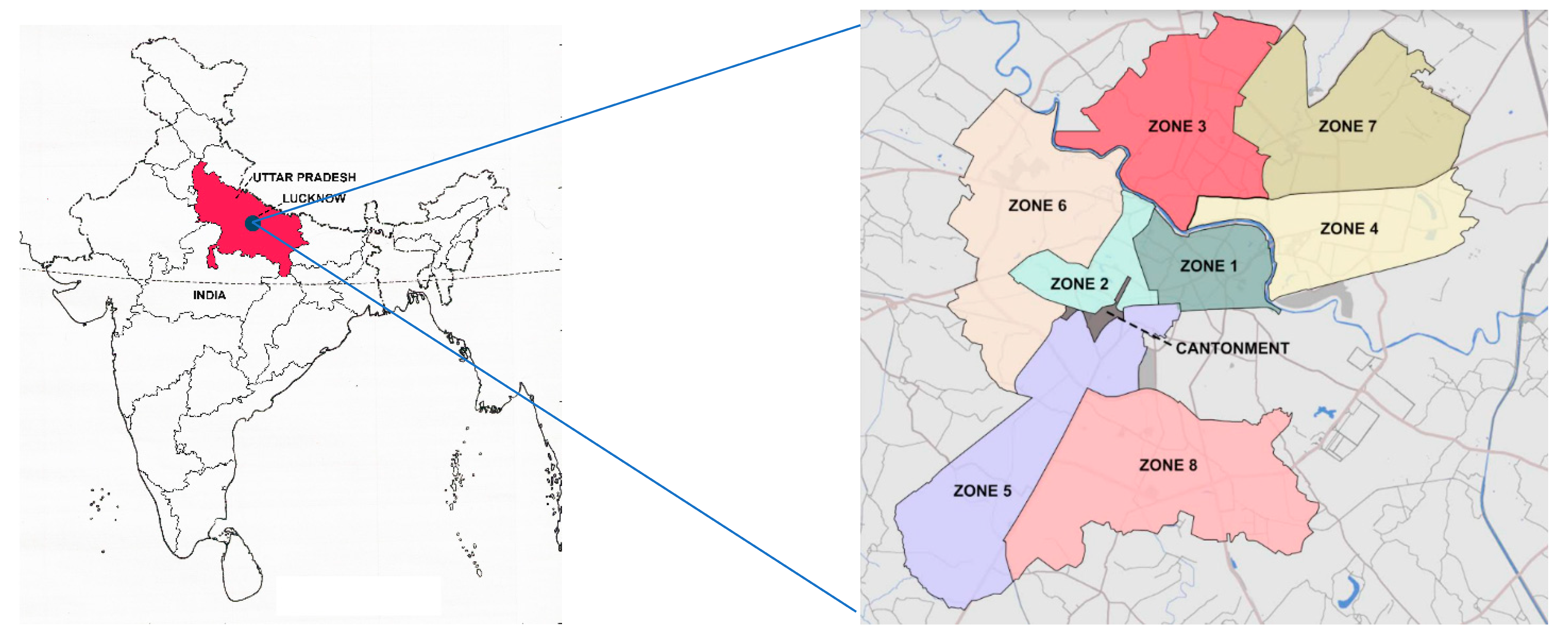
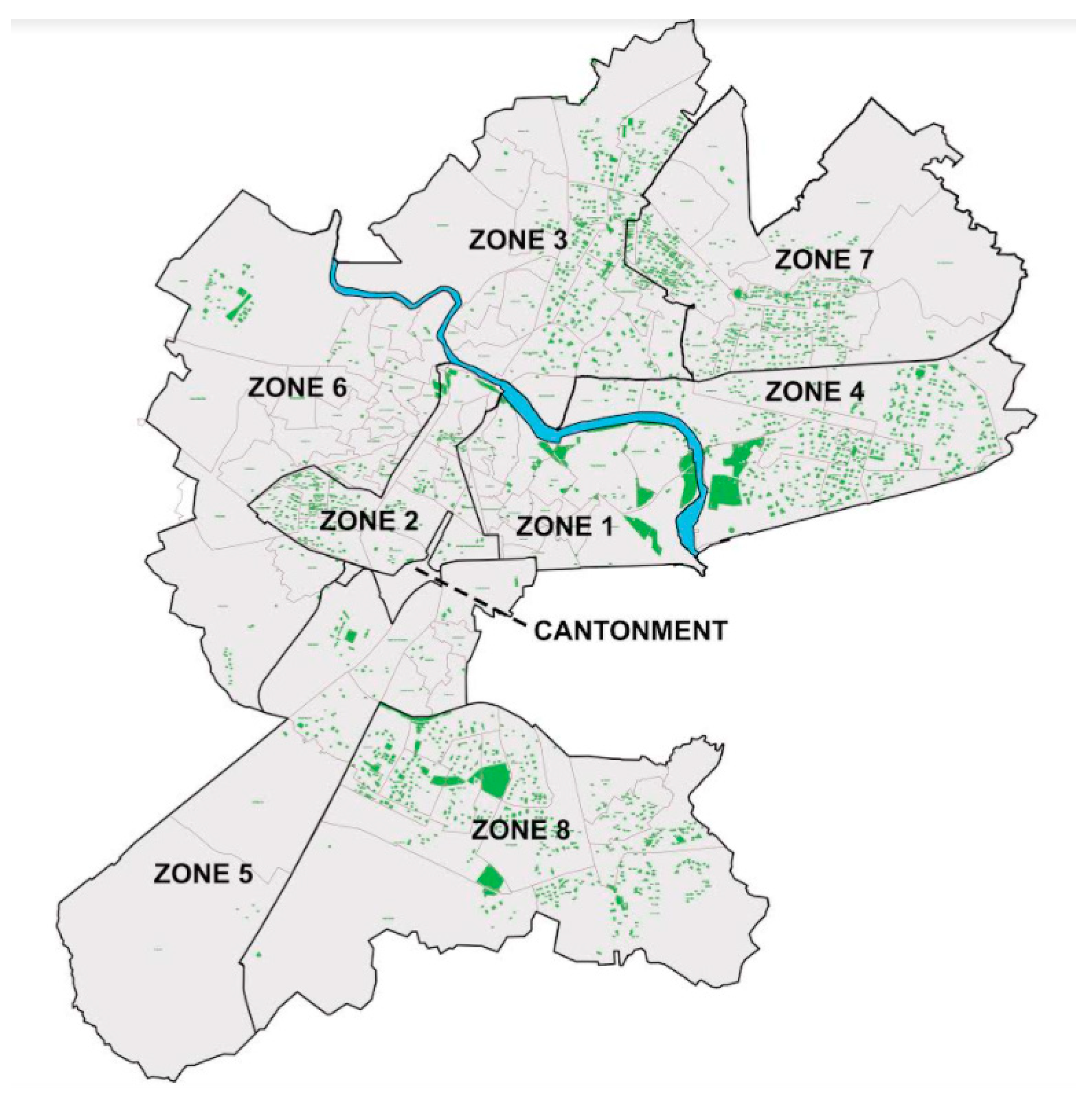
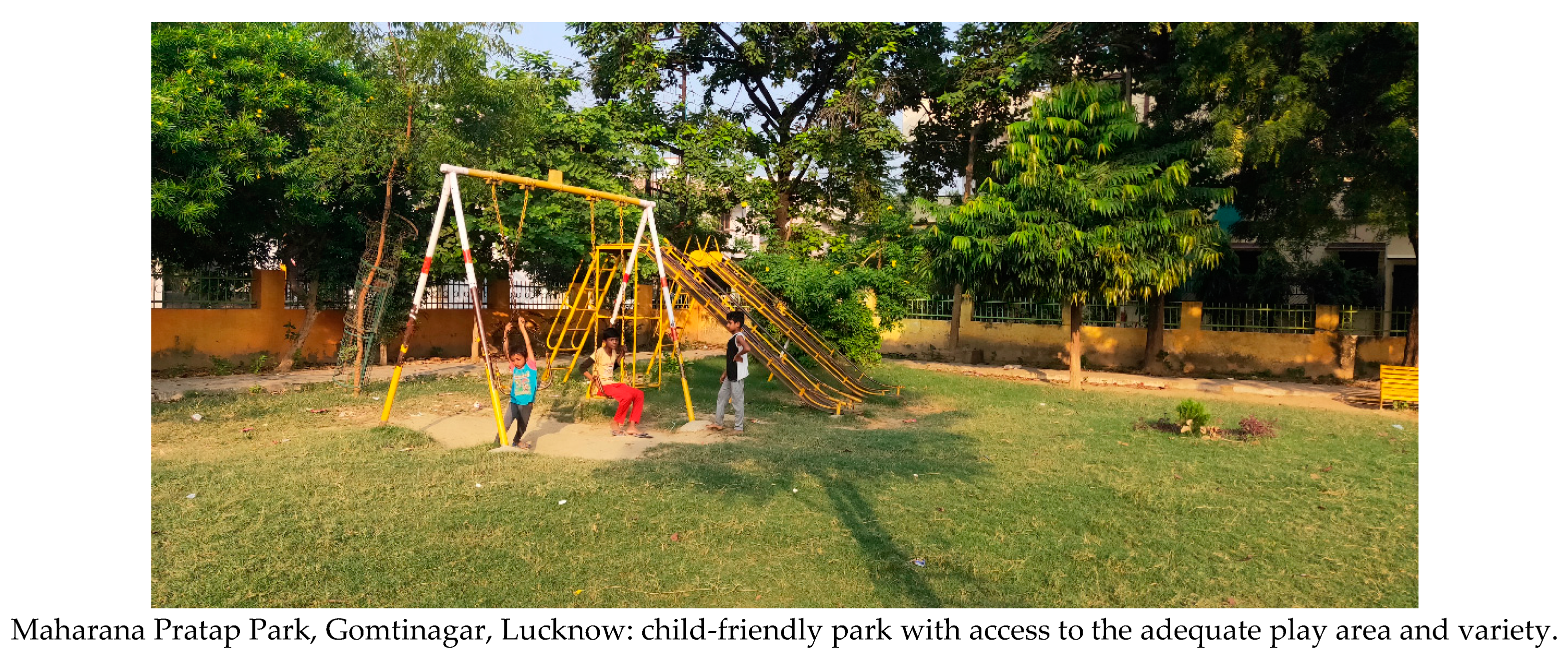
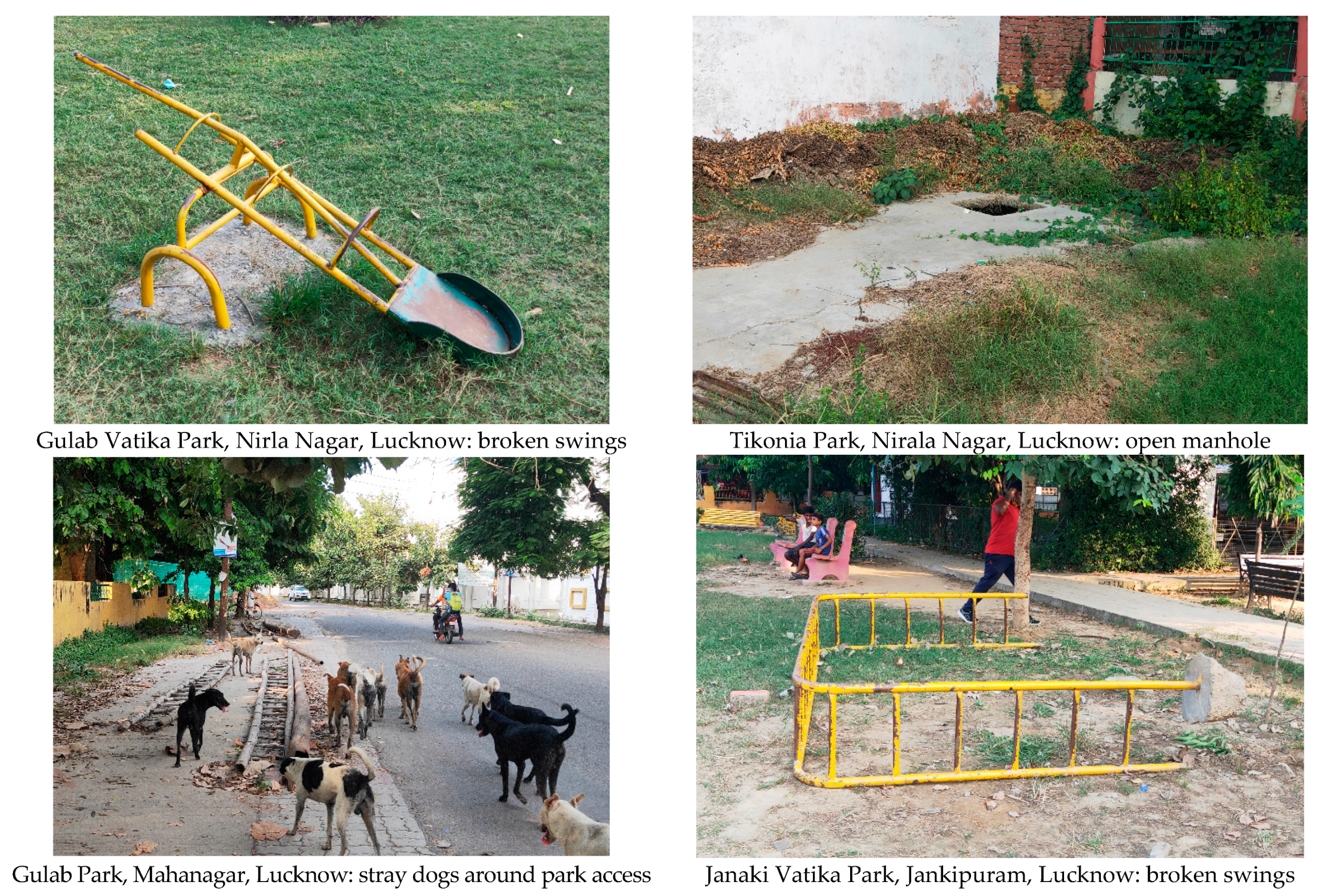
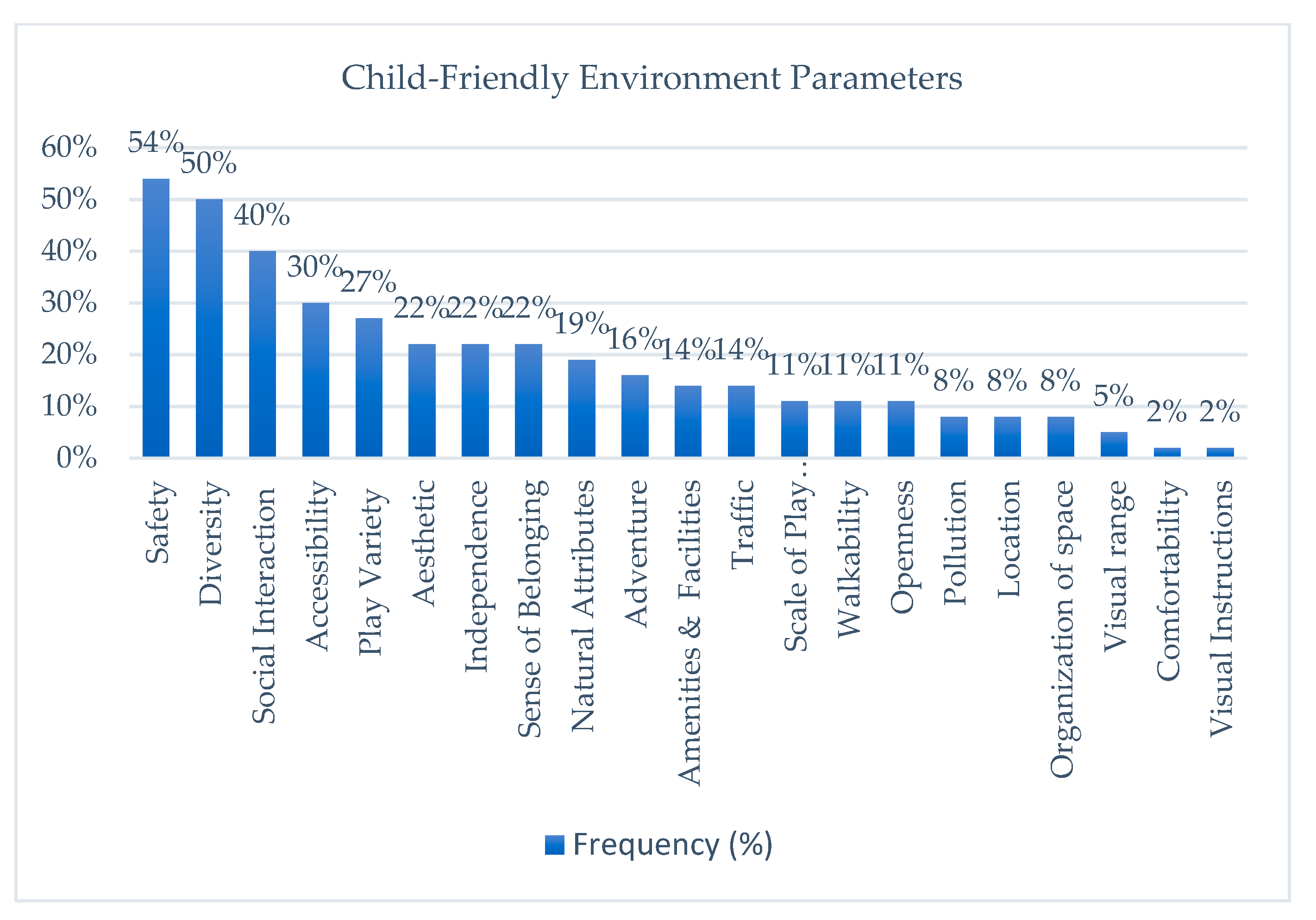
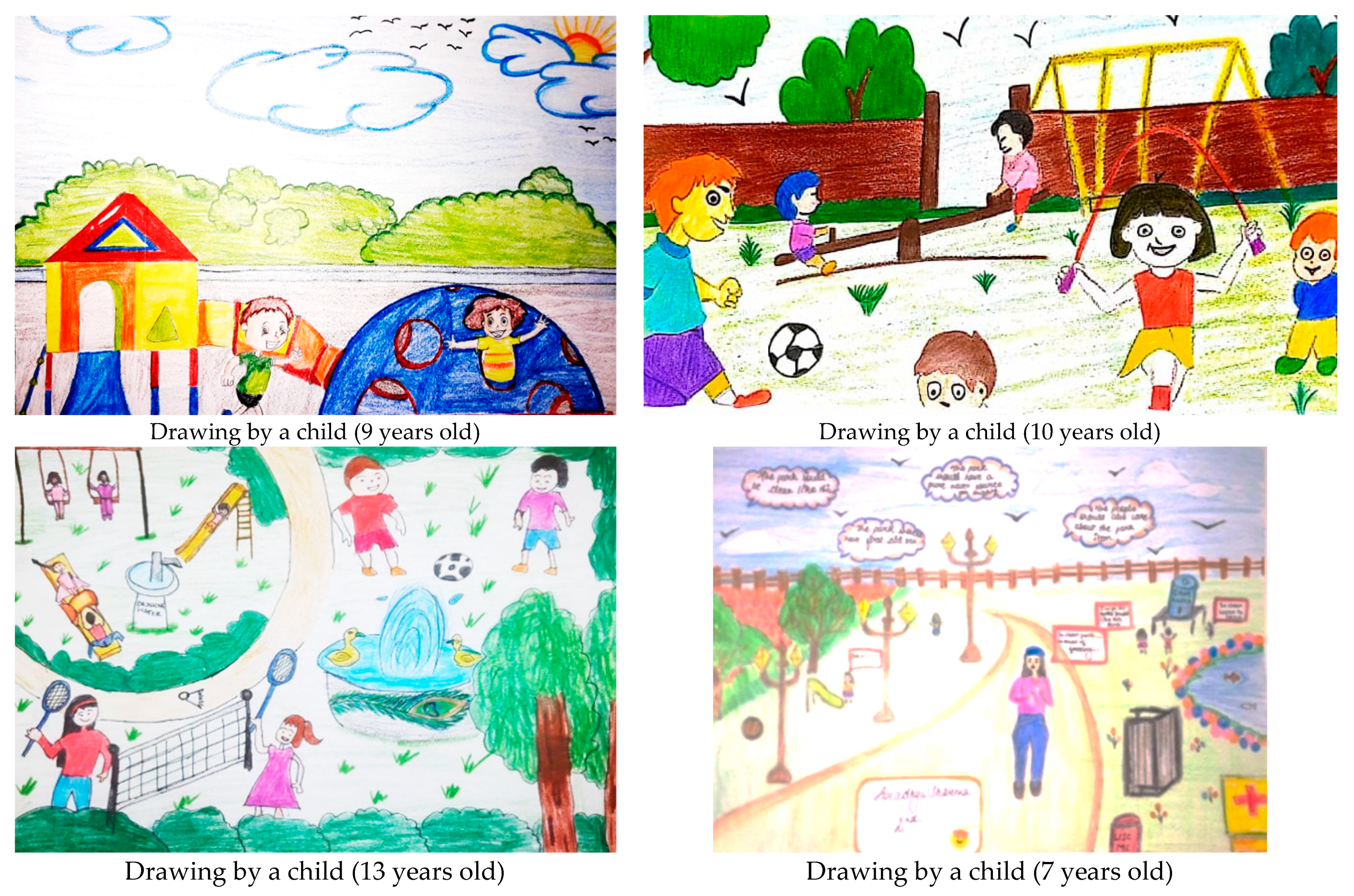
| Country/ Organisation | Open Space Standard |
|---|---|
| USA | 1.62 ha (4 acres) per 1000 population, equal to 16 m2 per person |
| UK | 2.43 ha (6 acres) per 1000 population, equal to 24 m2 per person |
| Australia | 2.83 ha (7 acres) per 1000 population, 28 m2 per person |
| Germany | 0.5 ha per person with the accessibility of 500 m |
| India | 10–12 m2 per person |
| UN-Habitat III | 15 percent of land should be allocated to open spaces |
| WHO | Standard of 9 m2 per person |
| Country | Quantity | Quality | Accessibility | Locality |
|---|---|---|---|---|
| UK | ✓ | ✓ | ✓ | ✓ |
| USA | ✓ | ✓ | ✓ | ✓ |
| Australia | ✓ | ✓ | ✓ | X |
| India | ✓ | X | X | X |
| Sr. No. | City | Theme | Child-Friendly Initiatives |
|---|---|---|---|
| 1 | Barcelona, Spain | Health and wellbeing | Super Block Barcelona has created child-friendly inner streets consisting of safe green spaces for culture, social activities, and fun. This is possible by restricting heavy traffic to main roads surrounding residential blocks. (Parameters adopted: traffic, play varieties, social interaction, safety, natural attributes) |
| 2 | Rotterdam, The Netherlands | Local economy | Building Blocks Rotterdam has created well-located public play spaces and amenities, with safe walkways and easily accessible green spaces for children. This has made the local urban environment attractive on one side and motivated the local economy. (Parameters adopted: location, accessibility, amenities and facilities, play varieties, social interaction, walkability and safety) |
| 3 | Bogotá, Colombia | Safety | Children’s Priority Zone Bogotá has created a childcare center surrounded by a children’s zone. This zone has slow traffic with streets for play and parks, better crossings, creating paved sidewalks, better landscaping, and social seating. These improvements have turned this zone into a child-friendly area. (Parameters adopted: traffic, play varieties, social interaction, independence, and walkability) |
| 4 | Santiago, Chile | Stronger communities | Bicentennia Children’s Park Santiago has taken many initiatives for creating a child-friendly environment such as continuously accessible walkways, public spaces of high-quality. The segregation between rich and poor has been minimized due to the creation of a child-friendly environment in the park. The park has developed safer play areas where children can have fun by doing various activities. (Parameters adopted: accessibility, play varieties, social interaction, independence and walkability parameters) |
| 5 | Qian’an City, China | Nature and sustainability | Sanlihe River Ecological Corridor The Sanlihe River Ecological Corridor in Qian’an City has become a favorite space for children. A heavily polluted 13km stretch of river has been changed into an attractive landscape for social activities. Walkways, paths, and cycle tracks have been networked in such a way that they have become meeting and activity points for children. (Parameters adopted: natural attributes, play varieties, social interaction, walkability and aesthetics parameters) |
| 6 | Copenhagen, Denmark | Resilience | Cloudburst Plan Copenhagen’s citywide plan has developed its existing urban area by creating a surface intervention based on green infrastructure. This city has developed an innovative system in which in case of heavy rains, cycle paths and sport pitches become waterways and reservoirs and water features are activated. (Parameters adopted: play varieties, natural attributes, social interaction and walkability) |
| 7 | Tirana, Albania | A catalyst for improving cities | Agents for change Child-friendly environments rectify urban problems such as road safety, pollution. Children in Tirana have taking initiatives for developing new play spaces by implementing the concept of car-free days. They have started campaigns such as “clean-up Tirana in a day” for household recycling. (Parameters adopted: safety, pollution, traffic, play varieties, adventure, diversity, social interaction and walkability) |
| Landuse | Small Cities | Medium Cities | Large Cities | Metro Cities |
|---|---|---|---|---|
| Recreational | 12–14% | 18–20% | 18–20% | 20–25% |
| 1–2 ha per 1000 persons | 1.4–1.6 ha per 1000 persons | 1.2–1.4 ha per 1000 persons | 1.2–1.4 ha per 1000 persons |
| Type | Category | Population Served per Unit | Area in (Ha) of Each |
|---|---|---|---|
| Housing cluster | 3–4 local parks and play grounds | 5000 | 0.50 |
| Sector/Neighborhood | 3–4 local parks and play grounds | 15,000 | 1.00 |
| Community | 2–3 Community level parks and play grounds | 100,000 | 5.00 |
| District | 1 District level park | 500,000 | 25.00 |
| Sub City Center | 1 City level park, sports complex, botanical/zoological garden, open ground (maidaan) | 10,00,000 | 100.00 |
| Sr. No. | Zone Name | Population | Area of Zone (Ha) | Area of Open and Green Spaces | Percent | Per Capita O/G Space m2 | |
|---|---|---|---|---|---|---|---|
| Ha | m2 | ||||||
| 1 | Zone-1 | 404,238 | 1654.24 | 120.74 | 1,207,400 | 7.29 | 2.99 |
| 2 | Zone-2 | 318,607 | 1177.81 | 27.17 | 271,700 | 2.31 | 0.85 |
| 3 | Zone-3 | 477,662 | 3951.55 | 85.64 | 856,400 | 2.17 | 1.79 |
| 4 | Zone-4 | 197,243 | 2702.67 | 187.39 | 1,873,900 | 6.93 | 9.50 |
| 5 | Zone-5 | 260,291 | 4405.52 | 20.43 | 204,300 | 0.46 | 0.78 |
| 6 | Zone-6 | 516,036 | 4538.15 | 37.07 | 370,700 | 0.82 | 0.72 |
| 7 | Zone-7 | 295,166 | 3839.95 | 57.33 | 573,300 | 1.49 | 1.94 |
| 8 | Zone-8 | 347,862 | 5329.96 | 203.85 | 2,038,500 | 3.83 | 5.86 |
| Total | 2,817,105 | 27,599.86 | 739.62 | 7,396,200 | 2.67 | 2.63 | |
| SUMMARY | ||||||
| Groups | Count | Sum | Average | Variance | ||
| Psychologist | 7 | 44 | 6.285714 | 0.238095 | ||
| Architects | 25 | 135 | 5.4 | 2.416667 | ||
| Planners | 9 | 56 | 6.222222 | 0.444444 | ||
| Pediatrician | 6 | 31 | 5.166667 | 4.966667 | ||
| ANOVA | ||||||
| Source of Variation | SS | df | MS | F | p-value | F crit |
| Between Groups | 8.735731 | 3 | 2.91191 | 1.425823 | 0.248337 | 2.821628 |
| Within Groups | 87.81746 | 43 | 2.042267 | |||
| Total | 96.55319 | 46 | ||||
| SUMMARY | Count | Sum | Average | Variance | ||
|---|---|---|---|---|---|---|
| Psychologists | 21 | 129.2857 | 6.156463 | 0.203887 | ||
| Pediatricians | 21 | 109.5 | 5.214286 | 0.078175 | ||
| Architects | 21 | 90.9616 | 4.331505 | 4.458295 | ||
| Planners | 21 | 117.5556 | 5.597884 | 0.475897 | ||
| Accessibility | 4 | 23.0746 | 5.768651 | 0.32379 | ||
| Amenities | 4 | 21.85841 | 5.464603 | 0.209597 | ||
| Traffic | 4 | 22.01619 | 5.504048 | 0.254563 | ||
| Pollution | 4 | 22.47175 | 5.617937 | 0.130698 | ||
| Openness | 4 | 24.04508 | 6.01127 | 0.452289 | ||
| Walkability | 4 | 23.08349 | 5.770873 | 0.269609 | ||
| Location | 4 | 21.25397 | 5.313492 | 0.089758 | ||
| Organization of Space | 4 | 21.1781 | 5.294524 | 0.104014 | ||
| Play Variety | 4 | 23.98857 | 5.997143 | 0.199821 | ||
| Adventure | 4 | 23.79968 | 5.949921 | 0.584776 | ||
| Safety | 4 | 24.84762 | 6.211905 | 0.308715 | ||
| Independence | 4 | 22.18921 | 5.547302 | 0.535158 | ||
| Affection and Regard | 4 | 23.2654 | 5.816349 | 0.888067 | ||
| Diversity | 4 | 20.96794 | 5.241984 | 0.486853 | ||
| Natural Attributes | 4 | 23.58984 | 5.89746 | 0.474791 | ||
| Aesthetics | 4 | 20.42413 | 5.106032 | 0.835659 | ||
| Scale of Play Equipment | 4 | 19.4473 | 4.861825 | 0.1436 | ||
| Social Interaction | 4 | 17.2905 | 4.322625 | 7.642533 | ||
| Visual Instructions | 4 | 15.17446 | 3.793616 | 6.078148 | ||
| Perception | 4 | 16.1031 | 4.025775 | 6.703536 | ||
| Sense of Belonging | 4 | 17.23354 | 4.308384 | 7.623682 | ||
| ANOVA | ||||||
| Source of Variation | SS | df | MS | F | p-value | F crit |
| Rows | 37.0668 | 3 | 12.3556 | 11.24051 | 0.00000597 | 2.758078 |
| Columns | 38.3729 | 20 | 1.918645 | 1.745488 | 0.050435 | 1.747984 |
| Error | 65.95217 | 60 | 1.099203 | |||
| Total | 141.3919 | 83 |
| Sr. No. | Parameters | Parameter Attributes |
|---|---|---|
| 1 | Physical | Amenities and facilities, Traffic, Openness (within the park), Walkability, Location, Organization of Space (within the park) |
| 2 | Cognitive | Play variety, Exploration and Challenges |
| 3 | Emotional | Safety, Freedom of movement, Affection, and Regards |
| 4 | Perception | Diversity, Biotic attributes, Aesthetics, Scale of Play equipment |
| 5 | Social | Shared Activities, Common spaces to play |
Publisher’s Note: MDPI stays neutral with regard to jurisdictional claims in published maps and institutional affiliations. |
© 2021 by the authors. Licensee MDPI, Basel, Switzerland. This article is an open access article distributed under the terms and conditions of the Creative Commons Attribution (CC BY) license (https://creativecommons.org/licenses/by/4.0/).
Share and Cite
Agarwal, M.K.; Sehgal, V.; Ogra, A. A Critical Review of Standards to Examine the Parameters of Child-Friendly Environment (CFE) in Parks and Open Space of Planned Neighborhoods: A Case of Lucknow City, India. Soc. Sci. 2021, 10, 199. https://doi.org/10.3390/socsci10060199
Agarwal MK, Sehgal V, Ogra A. A Critical Review of Standards to Examine the Parameters of Child-Friendly Environment (CFE) in Parks and Open Space of Planned Neighborhoods: A Case of Lucknow City, India. Social Sciences. 2021; 10(6):199. https://doi.org/10.3390/socsci10060199
Chicago/Turabian StyleAgarwal, Mohit Kumar, Vandana Sehgal, and Aurobindo Ogra. 2021. "A Critical Review of Standards to Examine the Parameters of Child-Friendly Environment (CFE) in Parks and Open Space of Planned Neighborhoods: A Case of Lucknow City, India" Social Sciences 10, no. 6: 199. https://doi.org/10.3390/socsci10060199
APA StyleAgarwal, M. K., Sehgal, V., & Ogra, A. (2021). A Critical Review of Standards to Examine the Parameters of Child-Friendly Environment (CFE) in Parks and Open Space of Planned Neighborhoods: A Case of Lucknow City, India. Social Sciences, 10(6), 199. https://doi.org/10.3390/socsci10060199






